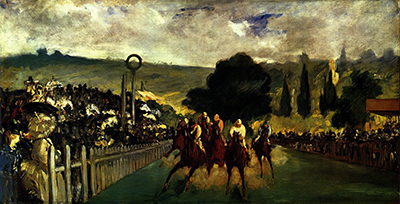Manet painted The Races at Longchamp in 1866. It's a groundbreaking painting in which Manet has chosen to place the viewer of the painting on the racecourse in front of the horses which are galloping towards them.
It combines some sharply painted elements, such as a stand on the right, with the impressionistic blur that is the pack of horses. This painting shows the artist at the height of his powers. Manet had started his professional career by painting The Absinthe Drinker in 1858. It was a subject very far removed from the privileged background that the young artist had grown up in. Manet's mother was a goddaughter of the Crown Prince of Sweden. His father was a judge and magistrate who hoped that his son would soon be following in his footsteps as a lawyer. He was destined to be disappointed.
As a boy, Manet was a friend of Proust, and a kindly uncle would take them both to the Louvre so that Manet could indulge his intense interest in painting and drawing. After a spell in the Navy, Manet spent the years 1850 to 1856 studying painting. He was much influenced by the old masters such as Goya and Velazquez but gradually came to the view that art should reflect contemporary life. However his love of Spanish culture continued and his work Spanish Guitar Player was his first painting to be accepted by the Parisian Salon.
The Salon rejected his famous Dejeuner sur l'herbe in 1863. However, French painters, annoyed at the Salon’s judgements, arranged an exhibition of those paintings which had been turned down. Manet's famous painting caused a storm of protest. But this exhibition set the stage for the development of Impressionism which is very much to the fore in the painting style of The Races at Longchamp.
Manet's work is notable for its ability to show the pleasures of life and here he looks at a race day in the Bois de Boulogne, outside Paris. It's noticeable that during the 1860s a number of painters took the enjoyment of Parisian life as a subject. True to his decision to show contemporary French life, the Longchamps racetrack was a new development in Paris– races started there in 1857. Manet originally intended to paint a panorama of the bustling scene on race day - it was usual for artists to paint horses racing, side on. In the final picture, the angle at which the horses are painted is an innovation, drawing the viewer into the action. The painting combines a sophisticated subject with an elemental energy and quite literally – animal spirit.
Manet did not make detailed drawings of his subjects before painting them. He tended to place forms and figures on a pale grey background to act as a guide for the finished painting. He was not a painter obsessed with perspective and the ideal rendering of three dimensions on a two-dimensional canvas. The ground of his paintings is actually quite shallow. He tended to use more paint for objects in the foreground, or the object of interest in the painting, and thinner layers of paint for the background and the less important areas of the picture. This draws attention to the important parts of the painting. He liked to suggest form and mass through subtle colouring and increased contrast between dark and light in the picture. Again, this slightly flattens the picture. Manet may have been influenced in this style by Japanese art which was very fashionable in this period.
He was a masterful user of black paint. Some Impressionists employed purple or blue when they had to paint shadows. But Manet's early influences – Goya and Velazquez - had taught him the dramatic use of black, particularly in combination with lighter colours. However he also loved bright colours and began adding white to various colours to make them brighter. He also used colours straight from the tube, a completely new way to paint. The Races at Longchamp then, shows Manet's contemporary sensibility in its subject, combined with his historical appreciation of the great masters, and of Japanese art, in its painting techniques. Further artworks of note include The Fifer, The Balcony and The Railway.




